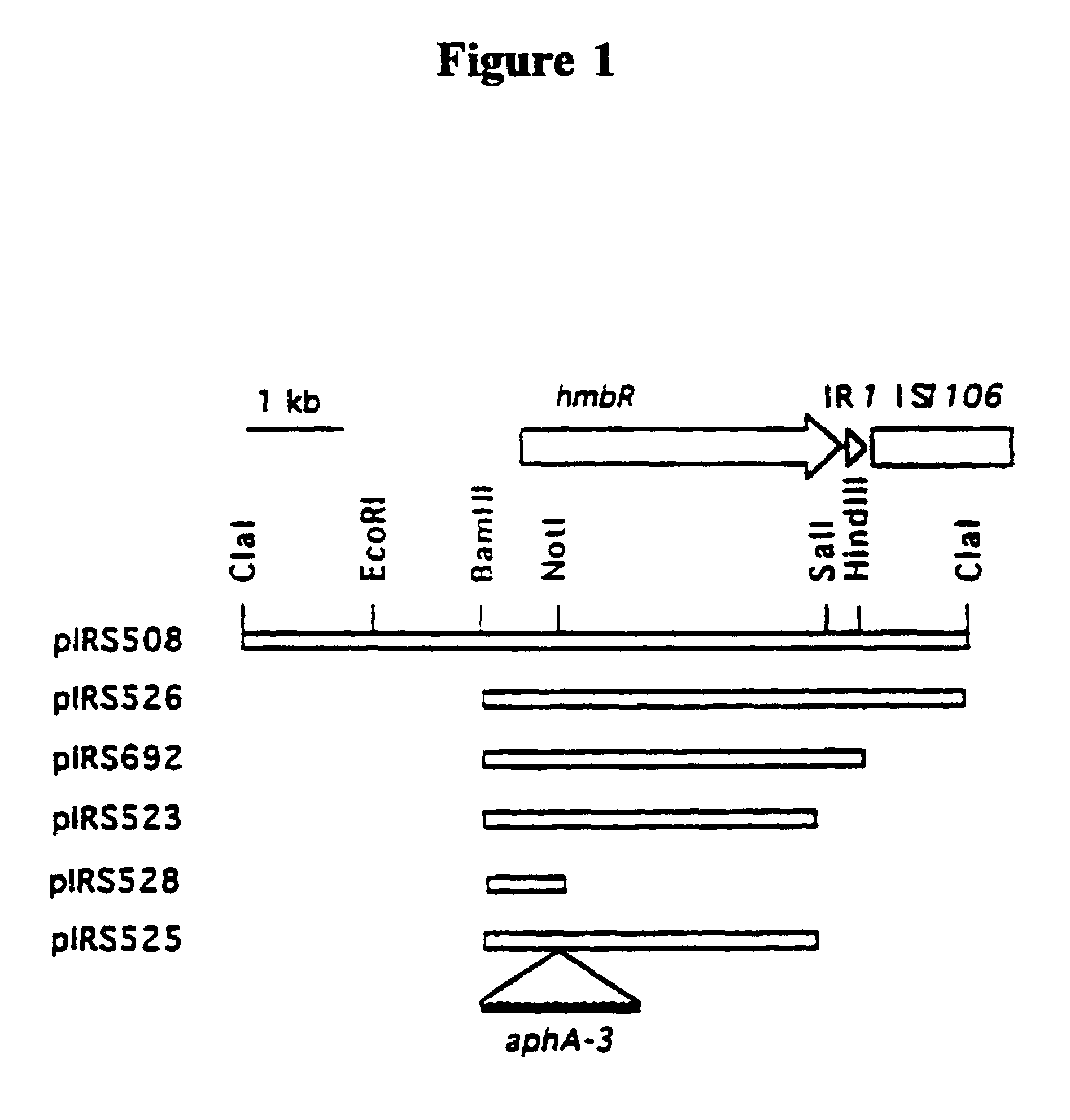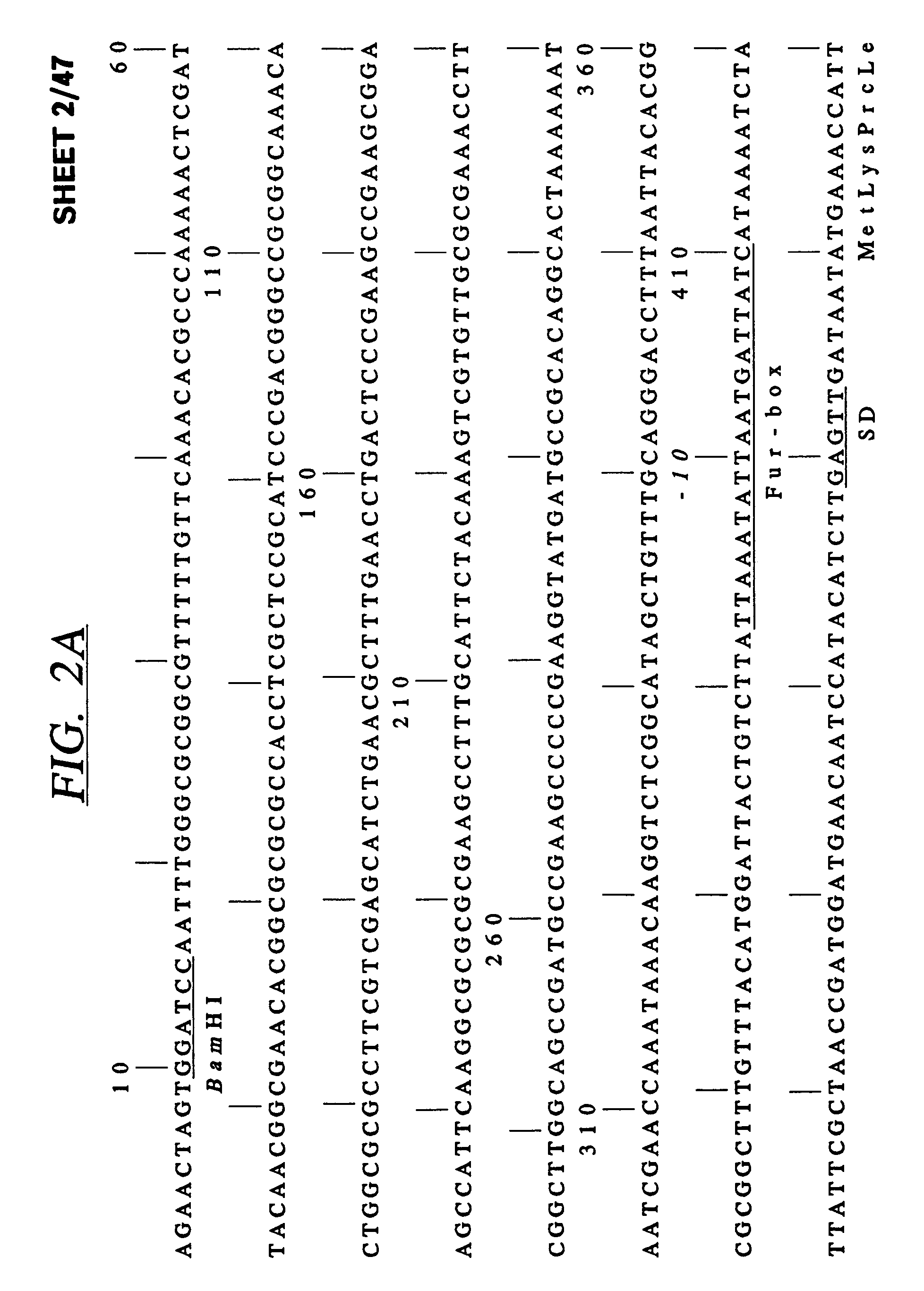Bacterial hemoglobin receptor genes
a technology of hemoglobin receptor and gene, applied in the field of bacterial hemoglobin receptor genes, can solve the problems of increasing the incidence of infections due to penicillinase-producing bacteria, increasing the cost of -lactam antibiotics, and increasing the success of antimicrobial treatment, so as to facilitate or modulate the biochemical activity, inhibit the effect of antimicrobial activity
- Summary
- Abstract
- Description
- Claims
- Application Information
AI Technical Summary
Benefits of technology
Problems solved by technology
Method used
Image
Examples
example 1
Plasmids, Bacteria, and Media
[0093]Plasmids and bacteria used herein are listed on Table 1. E. coli strains were routinely grown in Luria-Bertani (LB) broth supplemented with 5-aminolevulinic acid and 50 mg / L hemin chloride as necessary. N. meningitidis 8013 is a serogroup C clinical isolate (Nassif et al., 1993, Mol. Microbiol. 8: 719–725). The meningococci were routinely grown on GCB agar (Difco) supplemented as described by Kellogg et al. (1963, J. Bacteriol 85: 1274–1279), and incubated at 37° C. under a 5% CO2 atmosphere. Transformation of meningococci was performed as described by Nassif et al. (1992, Mol. Microbiol. 6: 591–597). When necessary, the following antibiotics were used with E. coli: rifampicin, 100 mg / L; tetracycline, 15 mg / L; kanamycin, 30 mg / L; chloramphenicol, 20 mg / L; carbenicillin, 100 mg / L. For Neisseriae, kanamycin at 100 mg / L was used when needed.
example 2
Auxotroph Complementation Cloning of a Hemoglobin Receptor Gene from Neisseria meningitidis
[0094]In order to identify N. meningitidis outer membrane receptor(s) involved in the uptake of hemin and / or hemoglobin iron, an auxotroph complementation cloning strategy was used, similar to the approach previously taken to identify the Y. enterocolitica and V. cholerae hemin receptors (see Stojiljkovic and Hantke, 1992, EMBO J. 11: 4359–4367; Henderson and Payne, 1994, J. Bacteriol. 176: 3269–3277). This strategy is based on the fact that the outer membrane of Gram-negative bacteria is impermeable to hemin (McConville and Charles, 1979, J. Microbiol. 113: 165–168) and therefore E. coli porphyrin biosynthesis mutants cannot grow on exogenously supplied hemin. If provided with the N. meningitidis outer membrane hemin receptor gene, the E. coli porphyrin mutant would be able to use exogenously supplied hemin as its porphyrin source.
[0095]A cosmid bank of N. meningitidis 8013 clone 6 DNA was p...
example 3
Restriction Enzyme Digestion Mapping of Hemin Utilization Positive Cosmids
[0098]Cosmid DNA from six hemin-utilization positive cosmids obtained as described in Example 2 were digested with ClaI, and the resulting fragments were cloned into ClaI-digested pSU(SK) vector (obtained from Stratagene, LaJolla, Calif.). One subclone, containing a 6 kb ClaI fragment from cosmid cos22 (the resultant plasmid was designated pIRS508), was determined to allow utilization of hemin and hemoglobin by E. coli hemA aroB assayed as described in Example 2. Another such clone, containing an 11 kb ClaI fragment from cos44 was also determined to allow hemin utilization in these auxotrophic mutant cells. Restriction analysis and Southern hybridization indicated that the DNA fragments originating from cos22 and cos44 are unrelated.
[0099]The deduced restriction enzyme digestion map of cosmid clone pIRS508 is shown in FIG. 1. Plasmid pIRS508 enabled E. coli hemA aroB to use both hemin and bovine hemoglobin as ...
PUM
| Property | Measurement | Unit |
|---|---|---|
| molecular weight | aaaaa | aaaaa |
| molecular weight | aaaaa | aaaaa |
| molecular weight | aaaaa | aaaaa |
Abstract
Description
Claims
Application Information
 Login to View More
Login to View More - R&D
- Intellectual Property
- Life Sciences
- Materials
- Tech Scout
- Unparalleled Data Quality
- Higher Quality Content
- 60% Fewer Hallucinations
Browse by: Latest US Patents, China's latest patents, Technical Efficacy Thesaurus, Application Domain, Technology Topic, Popular Technical Reports.
© 2025 PatSnap. All rights reserved.Legal|Privacy policy|Modern Slavery Act Transparency Statement|Sitemap|About US| Contact US: help@patsnap.com



